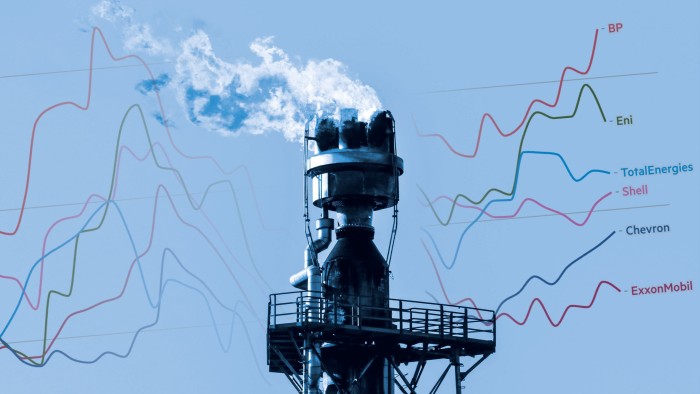Stay informed with free updates
Simply sign up to the Oil & Gas industry myFT Digest — delivered directly to your inbox.
The world’s largest oil companies are braced for a prolonged downturn in crude prices — the third in just over a decade — as they seek to reassure investors that they are prepared for the worst.
Executives at ExxonMobil, Chevron, Shell, TotalEnergies and BP have used their quarterly earnings updates to reassure investors that their balance sheets remain strong, and that they will not be rushed into unnecessary reductions in spending and shareholder returns.
“We are seeing significant downward pressure on prices and margins,” ExxonMobil chief Darren Woods told analysts this month, adding that the $472bn company had prepared for a downturn by cutting close to $13bn in costs over five years.
“Our organisation has planned for this. We pressure-test our plans and the financial outcomes with scenarios that are more severe than our Covid experience,” Woods said, referring to the 2020 slump that accompanied the pandemic. “No other international oil company even comes close.”
Oil prices dropped below $60 a barrel in April and are forecast to average about $65 for the remainder of the year, as the Opec+ cartel that includes Saudi Arabia and Russia continues to increase supply. Brent crude, the international benchmark, was trading below $65 a barrel on Friday.
Chevron, which is shrinking its workforce by a fifth, reassured investors that it would produce $9bn of free cash flow with oil at $60 a barrel. Shell said it would be able to pay its dividend even if oil dropped to $40, and that its share buybacks would continue at roughly half the current rate at $50 a barrel.
Shell added that it had not, so far, changed its spending plans. “We’re not asking our businesses to stop on projects,” said Sinead Gorman, chief financial officer, on the company’s earning call.
Patrick Pouyanné, chief executive of TotalEnergies, said the reaction this time was the same as during the coronavirus crisis — “no panic” — and noted how his company had declined to cut its dividend even during the worst of the pandemic.
Previous downturns in oil markets — including one that stemmed from the price wars between Saudi Arabia, the US and Russia from 2014 to 2016 — forced deep spending cuts on the industry as well as project delays. Debt also rose as Big Oil companies borrowed to maintain operations and shareholder returns.
Some also seized opportunities, such as Shell’s 2015 takeover of BG Group and Chevron’s acquisition of Noble Energy in 2020. “We’re better positioned than others to respond to market challenges and, in fact, take advantage of the opportunities they present,” noted Exxon’s Woods.
Big Oil collectively trimmed capital expenditure plans by 2 per cent over the course of the recent earnings season, estimated HSBC analyst Kim Fustier, who expected further reductions if oil prices remained at current levels.
Wood Mackenzie, the energy consultancy, has forecast $98bn in capital spending this year among the five supermajors — down nearly 5 per cent on 2023.
“They’re in a bit of a wait-and-see mode,” Fustier said. “They clearly don’t want to rush into any irreversible decisions.”
She also noted how the recent slide in crude prices came just weeks after a number of the big oil groups outlined long-term plans based on oil trading above $70 this year, making it tricky to revise guidance so soon. “I think the companies should have presented a plan where cash inflows and outflows are balanced at $65 a barrel, but none of them did,” Fustier added.
HSBC analysts cited the adjustment to lower oil prices as they cut their 2025 earnings per share forecast for the big listed oil companies, including by 35 per cent for BP and 18 per cent for Chevron.
Bank of America analyst Christopher Kuplent said that while $65-a-barrel oil might not cause major disruption for the majors, any further slide risked a more significant impact.
“My worry is we don’t stay at $65. Our house forecast is that across the second and third quarter, Brent crude will average below $60. That kind of scenario will reveal vulnerabilities,” he said.
Kuplent also said he disagreed with big oil groups’ claims that they were ready for a downturn, noting how a decade of cuts had left many companies with limited flexibility for further reductions without endangering oil and gas production.
“Ten years into an efficiency drive that has made a lot of companies a lot thinner, the scope to offer more is much reduced,” he said.
https://www.ft.com/content/1fb2a6c5-e735-4d9c-8d14-b8d410af28d9


